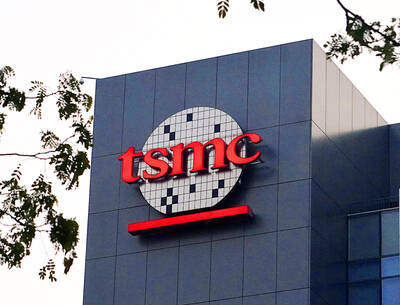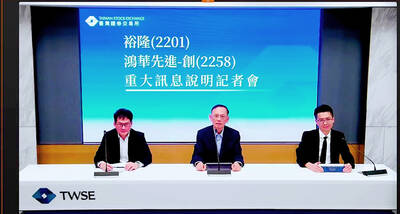Eight local petrochemical companies recently submitted applications to the Ministry of Economic Affairs to invest up to US$7 billion in a joint venture in China after the government this month removed some bans on China-bound investment, Petrochemical Industry Association of Taiwan (石化工業同業公會) chairman Jack Shieh (謝俊雄) said yesterday.
On Oct. 1, the ministry relaxed restrictions on Taiwanese petrochemical firms’ investment in China, but required them to hold at least 50 percent of shares in any Chinese joint venture.
Shieh said the eight companies plan to invest in a joint venture with China-based Sinopec Corp (中石化) in Fujian Province’s Gulei Peninsula, but the ministry’s Investment Commission yesterday said it had not yet received the applications.
The eight firms are Ho Tung Chemical Corp (和桐), Hsin Tay Petroleum Co Ltd (盛台), USI Corp (台聚), Asia Polymer Corp (亞聚), TSRC Corp (台橡), LCY Chemical Corp (榮化), Grand Pacific Petrochemical Corp (國喬) and Lien Hwa Industrial Corp (聯華氣體).
“The plan to build oil refineries and naphtha crackers in Fujian is still a rough draft and has not yet received approval from the government,” Shieh told reporters.
The portion of the shareholding among local firms has not yet been decided, Shieh said.
Formosa Plastics Group (FPG, 台塑集團) is still conducting an analysis on whether to increase petrochemical investment in China, FPG vice chairwoman Susan Wang (王瑞華) reportedly told reporters yesterday at a corporate event, as traditional naphtha crackers face challenges from the emerging shale gas industry.
The Industrial Technology Research Institute (ITRI) said in a report released yesterday that Taiwan’s petrochemical sector would see its output grow by between 3.3 and 3.9 percent this year from last year.
However, local manufacturers’ output for next year will grow by only between 1.5 and 2 percent due to intensifying competition in the global market arising from higher operating costs, the report said, saying that Chinese petrochemical firms will use locally produced raw materials to cut costs, while US firms will rely more on cheaper shale oil and gas to mass-produce ethylene and propylene products.
“The government should assist local petrochemical companies to enhance their competitiveness in the global market by reducing tariffs in the short tern,” ITRI analyst Tseng Fan-ming (曾繁銘) said.
“Taiwanese petrochemical firms also need to explore new markets, preferably Southeast Asian countries, to reduce reliance on China’s market, and produce more high value-added chemical products to increase their competitiveness,” he added.

CHIP RACE: Three years of overbroad export controls drove foreign competitors to pursue their own AI chips, and ‘cost US taxpayers billions of dollars,’ Nvidia said China has figured out the US strategy for allowing it to buy Nvidia Corp’s H200s and is rejecting the artificial intelligence (AI) chip in favor of domestically developed semiconductors, White House AI adviser David Sacks said, citing news reports. US President Donald Trump on Monday said that he would allow shipments of Nvidia’s H200 chips to China, part of an administration effort backed by Sacks to challenge Chinese tech champions such as Huawei Technologies Co (華為) by bringing US competition to their home market. On Friday, Sacks signaled that he was uncertain about whether that approach would work. “They’re rejecting our chips,” Sacks

Taiwan’s long-term economic competitiveness will hinge not only on national champions like Taiwan Semiconductor Manufacturing Co. (TSMC, 台積電) but also on the widespread adoption of artificial intelligence (AI) and other emerging technologies, a US-based scholar has said. At a lecture in Taipei on Tuesday, Jeffrey Ding, assistant professor of political science at the George Washington University and author of "Technology and the Rise of Great Powers," argued that historical experience shows that general-purpose technologies (GPTs) — such as electricity, computers and now AI — shape long-term economic advantages through their diffusion across the broader economy. "What really matters is not who pioneers

BUBBLE? Only a handful of companies are seeing rapid revenue growth and higher valuations, and it is not enough to call the AI trend a transformation, an analyst said Artificial intelligence (AI) is entering a more challenging phase next year as companies move beyond experimentation and begin demanding clear financial returns from a technology that has delivered big gains to only a small group of early adopters, PricewaterhouseCoopers (PwC) Taiwan said yesterday. Most organizations have been able to justify AI investments through cost recovery or modest efficiency gains, but few have achieved meaningful revenue growth or long-term competitive advantage, the consultancy said in its 2026 AI Business Predictions report. This growing performance gap is forcing executives to reconsider how AI is deployed across their organizations, it said. “Many companies

TAIWAN VALUE CHAIN: Foxtron is to fully own Luxgen following the transaction and it plans to launch a new electric model, the Foxtron Bria, in Taiwan next year Yulon Motor Co (裕隆汽車) yesterday said that its board of directors approved the disposal of its electric vehicle (EV) unit, Luxgen Motor Co (納智捷汽車), to Foxtron Vehicle Technologies Co (鴻華先進) for NT$787.6 million (US$24.98 million). Foxtron, a half-half joint venture between Yulon affiliate Hua-Chuang Automobile Information Technical Center Co (華創車電) and Hon Hai Precision Industry Co (鴻海精密), expects to wrap up the deal in the first quarter of next year. Foxtron would fully own Luxgen following the transaction, including five car distributing companies, outlets and all employees. The deal is subject to the approval of the Fair Trade Commission, Foxtron said. “Foxtron will be